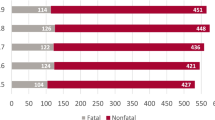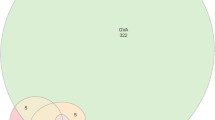Abstract
The concept of near-repeat patterns illustrates how crimes are clustered in space and time, with a crime event often shortly followed by another crime nearby. This study aims first to describe the frequency in shootings; second, to analyse the patterns of near-repeat shootings; and third, to validate a near-repeat calculator in the three largest cities in Sweden. Data were geocoded from three registries on shootings administered by the police departments in Stockholm, Gothenburg and Malmö from 2011 to 2015, and were analysed using a free near-repeat calculator. There were 948 shootings, 378 of which involved at least one injury or death (40%). The relative risk of firearm-perpetrated homicides was almost 2.5 times higher in Malmö compared to Stockholm, but almost half of the shootings occurred in Stockholm. Near-repeat patterns were found with a significantly increased risk of a new shooting in all three cities, but were weaker in Gothenburg.



Similar content being viewed by others
Notes
The serial shooter that operated in Malmö in 2003 to 2010 was apprehended before the observation period of this study and has not contributed with any shootings.
References
Ariel, B., and Partridge, H. Forthcoming. Predictable policing: Measuring the crime control benefits of hotspots policing at bus stops. Journal of Quantitative Criminology.
Abt, T., and Winship, C. 2016. What works in reducing community violence: A meta-review and field-study for the northern triangle. USAID Report, Task order AID-OOA-TO-13-00047.
Bernasco, W. 2008. Them again? Same-offender involvement in repeat and near repeat burglaries. European Journal of Criminology 5 (4): 411–431.
Block, S., and S. Fujita. 2013. Patterns of near repeat temporary and permanent motor vehicle thefts. Crime Prevention and Community Safety 15 (2): 151–167.
Bowers, K.J., and S.D. Johnson. 2004. Who commits near repeats? A test of the boost explanation. Western Criminology Review 5 (3): 12–24.
Braga, A., and D. Weisburd. 2012. The effects of “pulling levers” focused deterrence strategies on crime. Campbell Systematic Revies 2012: 6.
Butts, J.A., C.G. Roman, L. Bostwick, and J.R. Porter. 2015. Cure violence: a public health model to reduce gun violence. Annual Review of Public Health 36: 39–53.
Dedel, K. 2007. Drive-by Shootings. U.S. Department of Justice Office of Community Oriented Policing Services.
European Union. 2010. The Stockholm programme - An open and secure europeserving and protecting citizens [Official Journal C 115 of 4.5.2010].
Farrell, G. 2005. Progress and prospects in the prevention of repeat victimization. Handbook of crime prevention and community safety, 143–170.
Granath, S. 2012. Homicide in Sweden. In Handbook of European homicide research, 405–419. New York: Springer.
Haberman, C.P., and J.H. Ratcliffe. 2012. The predictive policing challenges of near repeat armed street robberies. Policing 6 (2): 151–166.
Hedlund, J., T. Masterman, and J. Sturup. 2016. Intra-and extra-familial child homicide in Sweden 1992–2012: a population-based study. Journal of Forensic and Legal Medicine 39: 91–99.
Hernandez, P. 2013. Is crime contagious? A near-repeat pattern analysis of burglary incidents in Winston-Salem, 2012. Journal of Justice Studies, 3.
Holgersson, S. 2008 Dialogpolis – Erfarenheter, iakttagelser och möjligheter 2002-2007. Växjö University studies in policing Nr 002-2008. Växjö university.
Hoppe, L. 2016. Near repeat burglary patterns in Malmö. A geospatial analysis of near repeat victimization patterns in Malmö between 2009 and 2014. Thesis in Criminology, Malmö University.
Johnson, D. 2013. The space/time behaviour of dwelling burglars: finding near repeat patterns in serial offender data. Applied Geography 41: 139–146.
Klein, M.W. 1995. The American street gang: Its nature, prevalence and control. New York: Oxford University Press.
Koper, C.S., and E. Mayo-Wilson. 2012. Police strategies to reduce illegal possession and carrying of firearms: effects on gun crime. Campbell Systematic Reviews 2012: 11.
Lasley, J.R. 1998. “Designing Out” gang homicides and street assaults. US Department of Justice, Office of Justice Programs, National Institute of Justice.
Leinfelt, F., and A. Rostami. 2012. The Stockholm gang model: PANTHER. Stockholm: Erlander AB.
Liem, M., and W.A. Pridemore. 2012. Handbook of European homicide research: patterns, explanations, and country studies. New York: Springer.
Lindström, P., and Martinez-Olsson, E. 2016. Färre villainbrott med Märk-DNA. En utvärdering av en försöksverksamhet. Malmö Högskola, Fakulteten för Hälsa och Samhälle. FoU-Rapport 2016:3.
Lockwood, B. 2012. The presence and nature of a near-repeat pattern of motor vehicle theft. Security Journal 25 (1): 38–56.
Marchione, E., and S.D. Johnson. 2013. Spatial, temporal and spatio-temporal patterns of maritime piracy. Journal of Research in Crime and Delinquency 50 (4): 504–524.
National Council for Crime Prevention. 2011. Det dödliga våldets utveckling. Stockholm: Brottsförebyggande rådet.
National Council for Crime Prevention 2012. Brottslighet och trygghet i Malmö, Stockholm och Göteborg. En kartläggning. Brottsförebyggande rådet, Stockholm
National Council for Crime Prevention. 2015a. Det dödliga våldet i Sverige 1990–2014: En beskrivning av utvecklingen med särskilt fokus på skjutvapenvåldet. Stockholm: Brottsförebyggande rådet.
National Council for Crime Prevention 2015b. Skjutningar 2006 och 2014 - omfattning, spridning och skador. BRÅ Kortanalys 7/2015.
Pease, K. 1998. Repeat victimisation: Taking stock. Crime detection and Prevention Series, Paper 90. Home Office: London.
Ratcliffe, J.H., and G.F. Rengert. 2008. Near-repeat patterns in Philadelphia shootings. Security Journal 21 (1–2): 58–76.
Ratcliffe, J.H. 2009 Near Repeat Calculator (version 1.3). Temple University, Philadelphia, PA and the National Institute of Justice, Washington, DC.
Rostami, A. 2016a. Criminal Organizing: Studies in the sociology of organized crime. Stockholm University.
Rostami, A. 2016b. Våldets betydelse för organisering av kriminella gäng. In Edling and Rostamis, eds. Våldets sociala dimension. Studentlitteratur, Lund.
Short, M.B., M.R. D’Orsogna, P.J. Brantingham, and G.E. Tita. 2009. Measuring and modeling repeat and near-repeat burglary effects. Journal of Quantitative Criminology 25 (3): 325–339.
Sturup, J. and Granath S. in review Unsolved homicides in Sweden 1990 to 2013 with special reference to firearm-perpetrated homicides.
Sturup, J., and P. Lindqvist. 2014. Psychosis and homicide in Sweden—A time trend analysis 1987–2006. International Journal of Forensic Mental Health 13 (1): 1–7.
Sturup, J., D. Karlberg, and M. Kristiansson. 2015. Unsolved homicides in Sweden: a population-based study of 264 homicides. Forensic Science International 257: 106–113.
Swedish National Police 2013. Shootings in the three metropolitan areas. Intelligence report HD110/13 [public version], Swedish National Police.
Swedish National Police 2015. Vulnerable neighbourhoods – social risk, collective ability and unwanted incidents [Utsatta områden – sociala risker, kollektiv förmåga och oönskade händelser]. Nationella Operativa Avdelningen (NOA), Swedish National Police.
The Government Offices of Sweden. 2016. Ygeman diskuterar illegala vapen på Balkan. Press release, February 16, Stockholm, Sweden.
Townsley, M., R. Homel, and J. Chaseling. 2003. Infectious burglaries. A test of the near repeat hypothesis. British Journal of Criminology 43 (3): 615–633.
Townsley, M., S.D. Johnson, and J.H. Ratcliffe. 2008. Space time dynamics of insurgent activity in Iraq. Security Journal 21 (3): 139–146.
United Nations Office on Drugs and Crime. 2013. Global study on homicide 2013: trends, contexts, data. Vienna: United Nations.
van Wilsem, J. 2004. Criminal victimization in cross-national perspective an analysis of rates of theft, violence and vandalism across 27 countries. European Journal of Criminology 1 (1): 89–109.
Weisel, D., and J. Stedman. 1998. Addressing community gang problems: A model for problem-solving. In Problem-oriented policing: Crime-specific problems, critical issues, and making POP work. Washington, DC: Police Executive Research Forum.
Wells, W., L. Wu, and X. Ye. 2011. Patterns of near-repeat gun assaults in Houston. Journal of Research in Crime and Delinquency, 0022427810397946.
Wells, W., L. Wu, and X. Ye. 2012. Patterns of near-repeat gun assaults in Houston. Journal of Research in Crime and Delinquency 49 (2): 186–212.
Wu, L., X. Xu, X. Ye, and X. Zhu. 2015. Repeat and near-repeat burglaries and offender involvement in a large Chinese city. Cartography and Geographic Information Science 42 (2): 178–189.
Wyant, B.R., R.B. Taylor, J.H. Ratcliffe, and J. Wood. 2012. Deterrence, firearm arrests, and subsequent shootings: a micro-level spatio-temporal analysis. Justice Quarterly 29 (4): 524–545.
Youstin, T.J., M.R. Nobles, J.T. Ward, and C.L. Cook. 2011. Assessing the generalizability of the near repeat phenomenon. Criminal Justice and Behavior 38 (10): 1042–1063.
Acknowledgements
This research was supported by an MSB – Swedish Civil Contingencies Agency grant to the Institute for Future Studies (2016-486/7045).
Author information
Authors and Affiliations
Corresponding author
Rights and permissions
About this article
Cite this article
Sturup, J., Rostami, A., Gerell, M. et al. Near-repeat shootings in contemporary Sweden 2011 to 2015. Secur J 31, 73–92 (2018). https://doi.org/10.1057/s41284-017-0089-y
Published:
Issue Date:
DOI: https://doi.org/10.1057/s41284-017-0089-y




